

How I became a Phantom artist? It happened this way... I had worked for Swedish Semic Press drawing riding-series for a magazine called "MIN HÄST" -
( My Horse ) since 1973 and drawing horses, little girls and stables for five years was a bit boring. I wished to have my own comic serie to be published and
made a few pages of an adventurous space-opera and showed it to my boss. Of course the riding-magazine couldn`t take it, but I hoped that in so big publishing
house than the multinational Semic with so many comic magazines, I would have a change. My adventurous pages disappeared inside Semic`s mouth of Molok
for weeks and I started to believe that they were totally forgotten. But then I was envited to another department of the house. It was the department that took
hand of Fantomen ( the Swedish name for The Phantom ). Ulf Granberg, the managing editor of the Phantom magazine, had seen my adventurous pages and
thought that my style would be suitable for Phantom. I was asked to make a couple of example-pages and those were accepted. I had my first real Phantom-
script in my hands and started to turn it into pictures as soon as I could.
Here is the first page of my 1st Phantomwork:
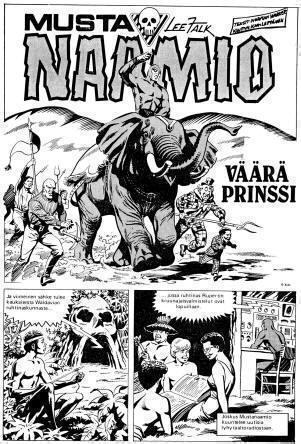
Since the "False Prince", which has been printed also in english by Australian FREW PUBLICATIONS, I have finished some 90 Phantom adventures ( date
October 20th 2008 ) and to knowledge many of them has been published outside Scandinavia, mainly in Australia, but also in countries like West Germany,
Brazil and England. The working with Phantom scripts has been interesting and full of challenges. Personally my favorites are the historical stories, and they
give me best satisfaction while I work. My first success was "The Siege of Malta"-story, which was a 3rd part of Norman Worker`s trilogy of St. John`s
Order in 16th Century. I worked with it while I was living in Tenerife, Canary Islands where it was hard to find enough referencies to illustrate authentic
events of the history. Norman Worker helped me by digging up plenty of useful pictures, even from British Museum.
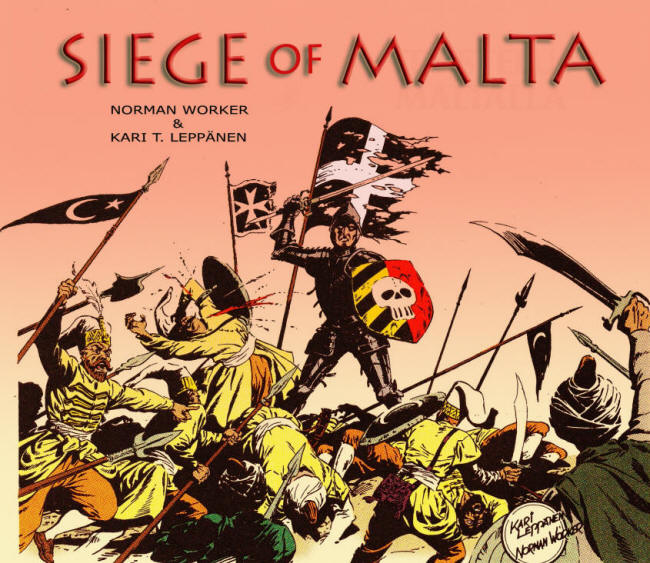

Since that inspiring story I have manufactured many other historical Phantom adventures during my Phantom years and it took many years until there
was next work that inspired me as much. It was rather recently published trilogy of "The Phantom Crusader", written by very talented Claes Rei-
merthi. The entire story was even more exciting than Norman Worker`s script. This time I had reference material more than enough, because the
recent movie of Ridley Scott had caused a boom of facta-books about crusaders to be handy. When I heard that readers had liked this pre-Phan-
tom story, where The Phantom even didn`t presented himself except in the first two pages, I was very pleased. I put every skill I had into that
Phantom work.
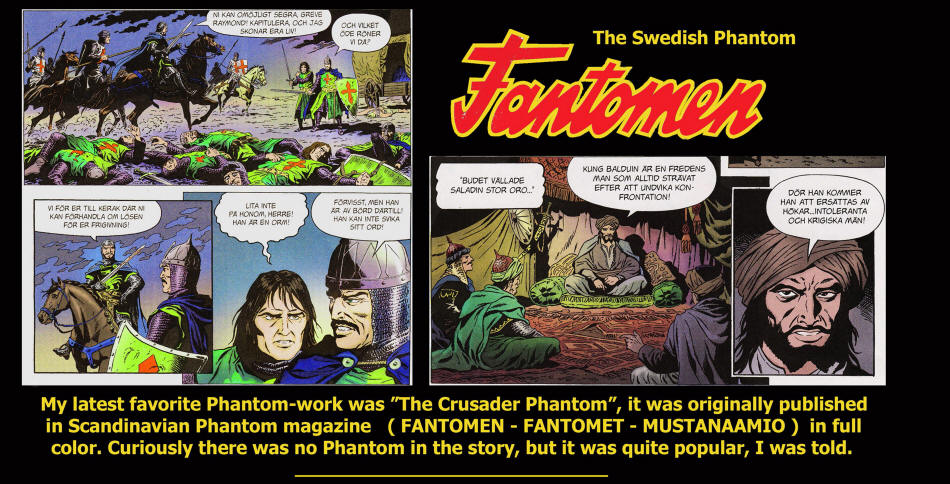

Usually in syndicate work the text and picture is made by two different people, and that´s the method with Phantom too. Lately only few artists had made
their own Phantom-stories with both the script and illustration. On of these is Hans Lindahl, very talented Phantom artist. another one is, I regret to say, my-
self, Kari T. Leppänen. I had thought a long time to make my own Phantom-story and finally I picked an idea of The Thirty Years War in Europe during
17th Century. I made it for two parts and gave it a name "THE RING OF DEATH".
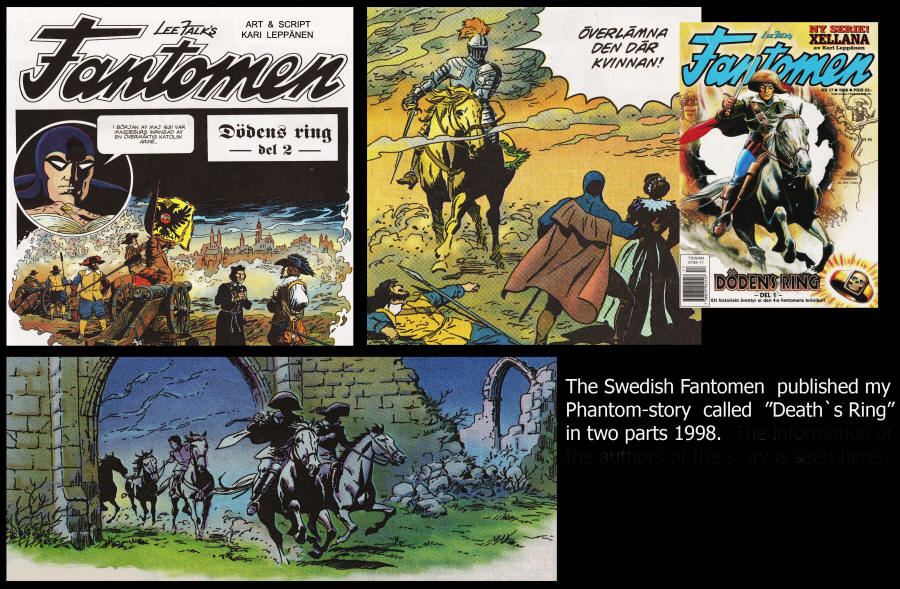
Below the same story published by Australian Frew Publications in enlish in two issues.
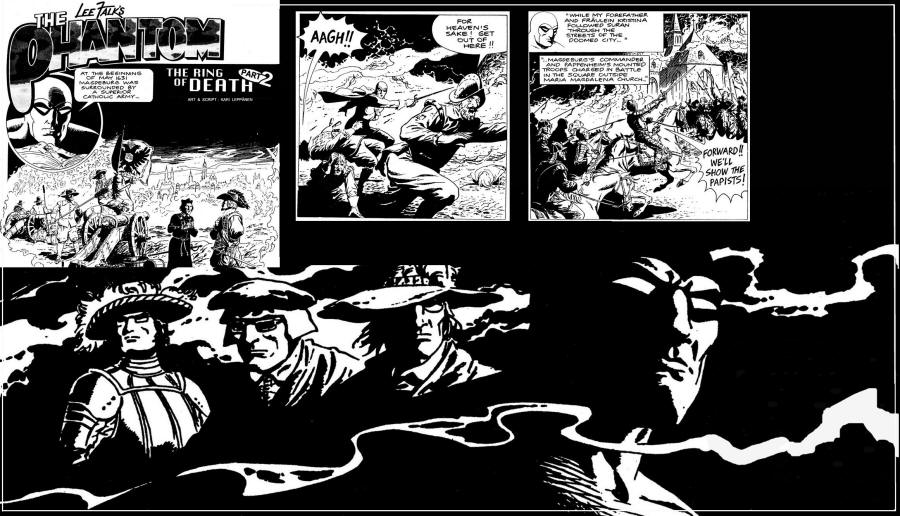
The Ring of Death was of course the Skull Ring of the Phantom. I choose it to have more strenght to my story and because the origin of the ring was then
handled only by Ulf Granberg, who told in his story "The Ring" that Paracelsus, the famous alchemist in 16th Century, gave it to the 1st Phantom. So I in-
vented my own story for the origin of the ring. In my story it had been made from the nails used in Christ´s crucifixion. That´s why it possessed strong divi-
ne powers, at least in the minds of jesuits, who ordered a priest to use it to kill the King of Sweden, Gustavus Adolphus. During the Thirty Years War the
papists thought that the king was an Antichrist from the North. A priest called Pater Capistrano stole the ring from the Phantom and did it twice in my sto-
ry. Of course he didn´t succeed to kill Gustavus Adolphus while trying to do so in the heat of Breitenfeld Battle.
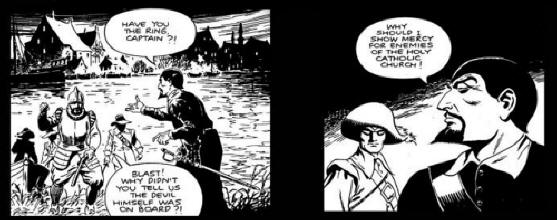

I borroved the type for pater Capistrano from an old story written in the first decade of 19th Century. Finnish story-teller Zacharias Tope-
lius wrote a historical story called "Välskärin kertomuksia" (Surgeons Tales) where the arch-villain was a jesuit by name of Hieronymus.
The book was illustrated by famous swedish artist Carl Larsson, and his picture of Hieronymus is abobe on the right. Some sources, after
seeing my illustrations, have thought that my example was Ming the Merciless from Flash Gordon, but that´s not true. However, I must ad-
mit that Capistrano resembles very much that vicked person in Alex Raymond´s Flash Gordon.

Ming the Merciless

ILLICIT USE OF MY ARTWORK:
A couple of years ago I happened to look inside a Finnish magazine called "Seura". It has been publishing american Phantoms for many years and I was
somehow curious to find out who was making the Sunday-pages recently. When I came to the Phantom-page I felt stunned. because the Phantom loo-
ked so familiar, familiar but in a rough way. By the second glance I recoqnized the familiarity. It was one of my Phantom-illustrations re-drawn. The same
story, but different artist has imitated my pictures. Sketching was made by George Olesen and inking by the long-time Mandrake-artist Fred Fredericks.
The pictures were so closely drawn after the originals that it looked a bit ridiculous, but I didn´t feel humorous. It was pure plagiarism.
If you are interested to see the result, click... plagiarism
I am still working with Phantom and will do as long as possible. Recently I have been illustrating mostly only historic stories of our hero.
Those have been very workable because I had tried to concentrated to authentic details of the period of history in every story. Below is
a skull that will lead you to the story which I´m presently working with...
click for the coming phantom story
GO: ACHILLES WIGGEN XELLANA JOHN CARTER OTHER COMICS SCIFI